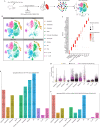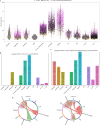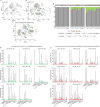Synergistic effects of PA (S184N) and PB2 (E627K) mutations on the increased pathogenicity of H3N2 canine influenza virus infections in mice and dogs
- PMID: 40183583
- PMCID: PMC12090714
- DOI: 10.1128/jvi.01984-24
Synergistic effects of PA (S184N) and PB2 (E627K) mutations on the increased pathogenicity of H3N2 canine influenza virus infections in mice and dogs
Abstract
As companion animals, dogs are susceptible to various subtypes of influenza A virus (IAV), with the H3N2 and H3N8 subtypes of canine influenza virus (CIV) stably circulating among canines. Compared to the H3N8 CIV, the H3N2 CIV is more widely prevalent in canine populations and demonstrates increased adaptability to mammals, potentially facilitating cross-species transmission. Therefore, a comprehensive elucidation of the mechanisms underlying H3N2 CIV adaptation to mammals is imperative. In this study, we serially passaged the GD14-WT strain in murine lungs, successfully establishing a lethal H3N2 CIV infection model. From this model, we isolated the lethal strain GD14-MA and identified the key lethal mutations PA(S184N) and PB2(E627K). Moreover, the GD14-ma[PA(S184N)+PB2(E627K)] strain exhibited markedly enhanced pathogenicity in dogs. Viral titers in lung tissues from infected dogs and mice showed that GD14-ma[PA(S184N)+PB2(E627K)] does not increase its pathogenicity to mice and dogs by upregulating viral titers compared to the GD14-WT strain. Notably, sequence alignments across all H3N2 IAVs showed an increasing prevalence of the PA (S184N) and PB2 (E627K) mutations from avian to human hosts. Finally, single-cell RNA sequencing of infected mouse lung tissues showed that GD14-ma[PA(S184N)+PB2(E627K)] effectively evaded host antiviral responses, inducing a robust inflammatory reaction. Considering the recognized role of the PB2 (E627K) mutation in the mammalian adaptation of IAVs, our findings underscore the importance of ongoing surveillance for the PA (S184N) mutation in H3N2 IAVs.IMPORTANCESince the 21st century, zoonotic viruses have frequently crossed species barriers, posing significant global public health challenges. Dogs are susceptible to various influenza A viruses (IAVs), particularly the H3N2 canine influenza virus (CIV), which has stably circulated and evolved to enhance its adaptability to mammals, including an increased affinity for the human-like SAα2,6-Gal receptor, posing a potential public health threat. Here, we simulated H3N2 CIV adaptation in mice, revealed that the synergistic PA(S184N) and PB2(E627K) mutations augment H3N2 CIV pathogenicity in dogs and mice, and elucidated the underlying mechanisms at the single-cell level. Our study provides molecular evidence for adapting the H3N2 CIV to mammals and underscores the importance of vigilant monitoring of genetic variations in H3N2 CIV.
Keywords: H3N2 canine influenza virus; cross-species transmission; host adaptation; single-cell RNA sequencing.
Conflict of interest statement
The authors declare no conflict of interest.
Figures






Similar articles
-
Zoonotic Risk, Pathogenesis, and Transmission of Avian-Origin H3N2 Canine Influenza Virus.J Virol. 2017 Oct 13;91(21):e00637-17. doi: 10.1128/JVI.00637-17. Print 2017 Nov 1. J Virol. 2017. PMID: 28814512 Free PMC article.
-
PB2 E627K or D701N substitution does not change the virulence of canine influenza virus H3N2 in mice and dogs.Vet Microbiol. 2018 Jul;220:67-72. doi: 10.1016/j.vetmic.2018.05.004. Epub 2018 May 9. Vet Microbiol. 2018. PMID: 29885803
-
The PB2 I714S mutation influenced mammalian adaptation of the H3N2 canine influenza virus by interfering with nuclear import efficiency and RNP complex assembly.Emerg Microbes Infect. 2024 Dec;13(1):2387439. doi: 10.1080/22221751.2024.2387439. Epub 2024 Aug 14. Emerg Microbes Infect. 2024. PMID: 39139051 Free PMC article.
-
A Review of Cross-Species Transmission Mechanisms of Influenza Viruses.Vet Sci. 2025 May 7;12(5):447. doi: 10.3390/vetsci12050447. Vet Sci. 2025. PMID: 40431540 Free PMC article. Review.
-
Influenza Virus Genomic Mutations, Host Barrier and Cross-species Transmission.Curr Genomics. 2025;26(3):161-174. doi: 10.2174/0113892029316603240926051325. Epub 2024 Oct 11. Curr Genomics. 2025. PMID: 40433418 Free PMC article. Review.
References
-
- Chen Y, Liang W, Yang S, Wu N, Gao H, Sheng J, Yao H, Wo J, Fang Q, Cui D, et al. . 2013. Human infections with the emerging avian influenza a H7N9 virus from wet market poultry: clinical analysis and characterisation of viral genome. Lancet 381:1916–1925. doi:10.1016/S0140-6736(13)60903-4 - DOI - PMC - PubMed
MeSH terms
Substances
Grants and funding
LinkOut - more resources
Full Text Sources
Research Materials

